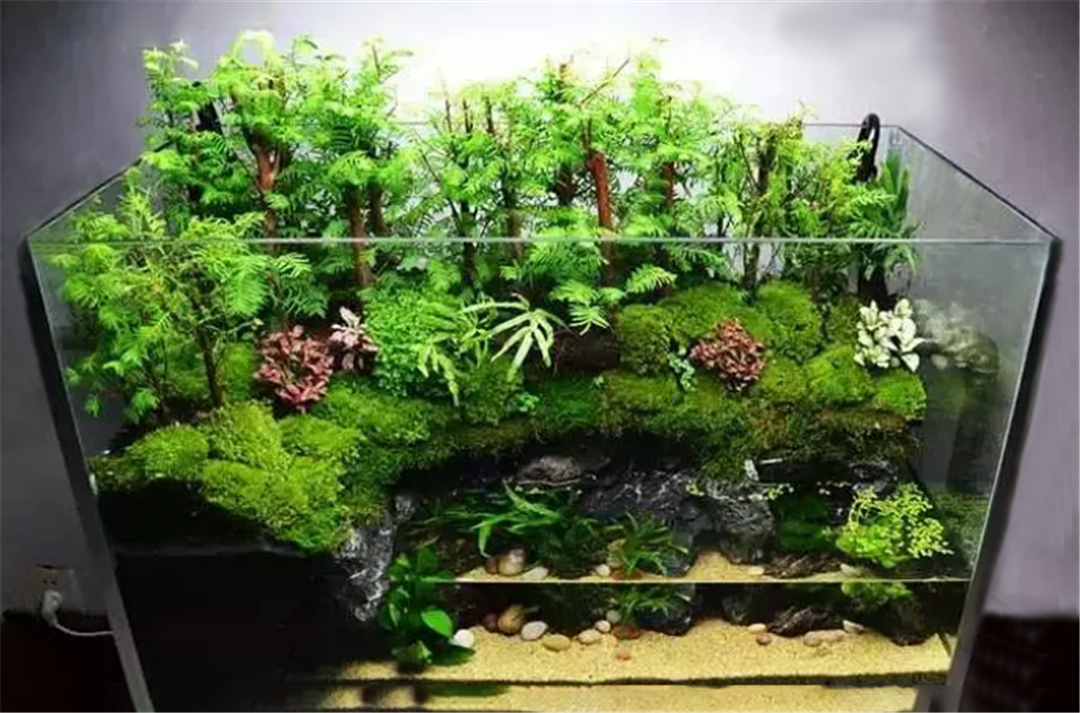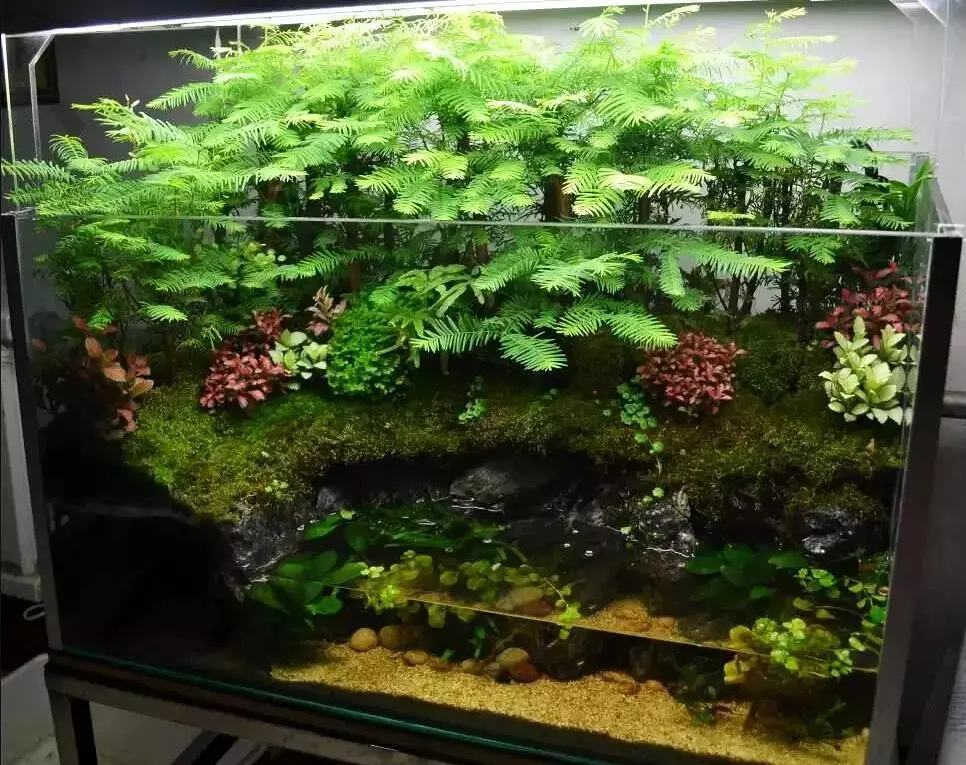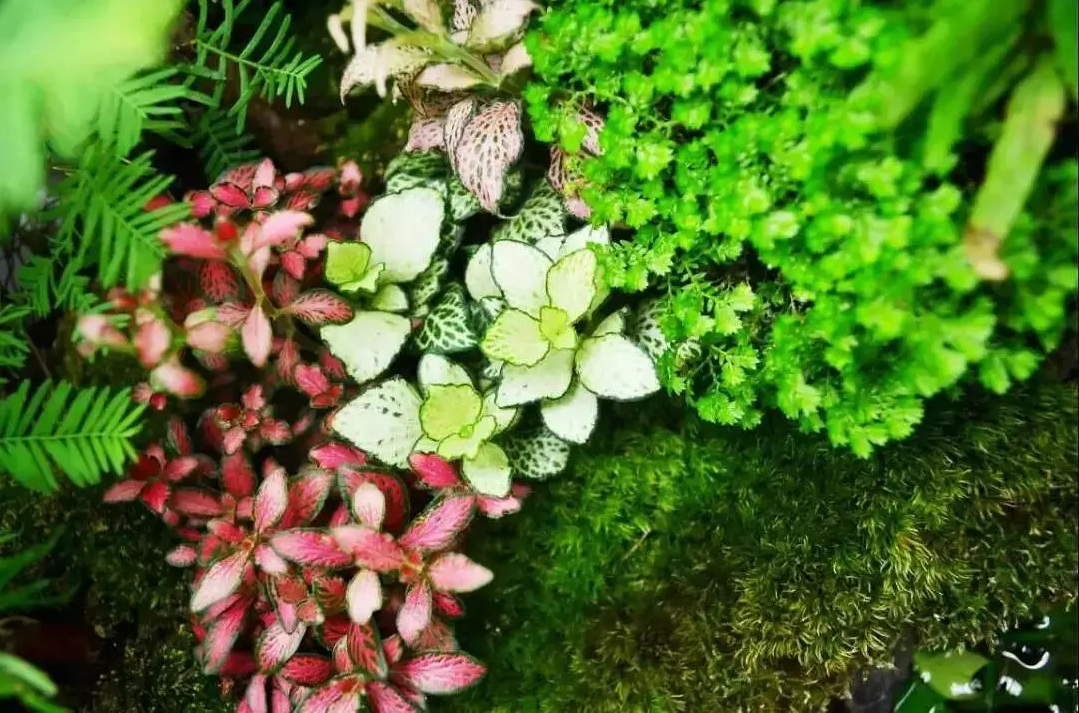By Jelly | 07 January 2020 | 1 Comments
How to Make a Paludarium? ——Aquascaping Knowledge Get You Done!
Overall Configuration of Fish Tank

Fish Tank Size: 80*40*45 cm
Lighting: Adjustable LED Aquarium Light 5W/8W/11W/16W
Bottom Mud Material: Volcanic Stone, Light Stone, Thin Filter Sponge, Foam Plastic Cloth, Water Moss, Planting Soil (Peat soil, Vermiculite, Perlite)
Material: Dynasty Jade Stone, Tank divider, Landscaping Glue
Plants: Leucobryum juniperoideum, Giraldiella levieri, Metasequoia glyptostroboides, Hydrocotyle sibthorpioides, Ferns etc.
Finished Paludarium Appreciation
In the beginning, some hydroponic plants were cultivated in the water grass tank. Later, I wondered if it would be better to plant some wet plants on the water. I searched a lot of information on the Internet, so then the aquascaping journey began.

I believe everyone has a certain understanding of planted tanks and water tanks. But Paludarium that can both keep plants and raise fish is not so simple.
The first thing to consider is how to isolate the water surface from the land and try to maintain the size of the water substance as much as possible.
It was known that most of the Paludarium tanks' water substances are just a small piece you saw before, and there is less space for fish to move. If they can be improved, they can both raise fish and landscape plants. After considering several methods and materials, it was finally decided to choose a partition tank divider commonly used by everyone in the Vivarium to build a base, which was quite successful.

This kind of plastic fish tank divider can play a great role in the landscaping of the fish tank. In this Paludarium fish tank, its fast, convenient and practical functions are highlighted.
Firstly, splice the head and tail of the partition board together, and then cut the partition board into an appropriate size according to the fish tank. And as a base, place it at the bottom of the fish tank.

Then you can spread a layer of foam plastic on the partition to prevent the mud from falling through to the bottom and spreading.
Then in this order, you can lay the material on the partition:
From bottom to top:
Volcanic Stone, Light Stone, Thin Filter Sponge, Foam Plastic Cloth, Water Moss, Planting Soil (Peat soil, Vermiculite, Perlite)
After the foundation is done, the Dynasty Jade Stone can be gently inserted into the soil. Moss and other plants can be placed around it.
Here I put Leucobryum juniperoideum, Giraldiella levieri, Metasequoia glyptostroboides, Hydrocotyle sibthorpioides, Ferns and so on. The sticking tool I use is Aquarium Underwater Safe Glue.
When all the steps are completed, pour the water slowly into the blank space along the edge of the fish tank. (Note: Do not use the impact water flow here, It will lead to soil base damage.)
Finally, the fixed steps we know - water circulation, water purification. (Here is the same treatment as the general fish tank)
When the water quality of the fish tank is acceptable, you can put the cute fish in it.

Details Appreciation






Note: This fish tank is best not to raise too many fish or large and medium fish. The capacity of water is limited, so the environment in which the fish are grown must be considered.
Hope this article can be helpful and useful for fishkeeping lovers.
Please let us know in the comments below for more suggestions!
You may also want to read:

Fish Tank Size: 80*40*45 cm
Lighting: Adjustable LED Aquarium Light 5W/8W/11W/16W
Bottom Mud Material: Volcanic Stone, Light Stone, Thin Filter Sponge, Foam Plastic Cloth, Water Moss, Planting Soil (Peat soil, Vermiculite, Perlite)
Material: Dynasty Jade Stone, Tank divider, Landscaping Glue
Plants: Leucobryum juniperoideum, Giraldiella levieri, Metasequoia glyptostroboides, Hydrocotyle sibthorpioides, Ferns etc.
Finished Paludarium Appreciation
In the beginning, some hydroponic plants were cultivated in the water grass tank. Later, I wondered if it would be better to plant some wet plants on the water. I searched a lot of information on the Internet, so then the aquascaping journey began.

I believe everyone has a certain understanding of planted tanks and water tanks. But Paludarium that can both keep plants and raise fish is not so simple.
The first thing to consider is how to isolate the water surface from the land and try to maintain the size of the water substance as much as possible.
It was known that most of the Paludarium tanks' water substances are just a small piece you saw before, and there is less space for fish to move. If they can be improved, they can both raise fish and landscape plants. After considering several methods and materials, it was finally decided to choose a partition tank divider commonly used by everyone in the Vivarium to build a base, which was quite successful.

This kind of plastic fish tank divider can play a great role in the landscaping of the fish tank. In this Paludarium fish tank, its fast, convenient and practical functions are highlighted.
Firstly, splice the head and tail of the partition board together, and then cut the partition board into an appropriate size according to the fish tank. And as a base, place it at the bottom of the fish tank.

Then you can spread a layer of foam plastic on the partition to prevent the mud from falling through to the bottom and spreading.
Then in this order, you can lay the material on the partition:
From bottom to top:
Volcanic Stone, Light Stone, Thin Filter Sponge, Foam Plastic Cloth, Water Moss, Planting Soil (Peat soil, Vermiculite, Perlite)
After the foundation is done, the Dynasty Jade Stone can be gently inserted into the soil. Moss and other plants can be placed around it.
Here I put Leucobryum juniperoideum, Giraldiella levieri, Metasequoia glyptostroboides, Hydrocotyle sibthorpioides, Ferns and so on. The sticking tool I use is Aquarium Underwater Safe Glue.
When all the steps are completed, pour the water slowly into the blank space along the edge of the fish tank. (Note: Do not use the impact water flow here, It will lead to soil base damage.)
Finally, the fixed steps we know - water circulation, water purification. (Here is the same treatment as the general fish tank)
When the water quality of the fish tank is acceptable, you can put the cute fish in it.

Details Appreciation






Note: This fish tank is best not to raise too many fish or large and medium fish. The capacity of water is limited, so the environment in which the fish are grown must be considered.
Hope this article can be helpful and useful for fishkeeping lovers.
Please let us know in the comments below for more suggestions!
You may also want to read:
Recently Reviews
Read MoreLeave a Reply
Your email address will not be published.Required fields are marked. *
CATEGORIES
- Aquarium Knowledge
- Aquarium Fishes
- Aquatic Plants
- Other Aquatic Creatures
- Best Aquarium Products
- Aquarium Light
- Aquarium Feeding Knowledge
- Fish Tank & Turtle Tank
- Aquarium Cleaning
- Fish Breeding
- Aquarium Heater
- Aquarium Filtration
- Planted Tank CO2
- Aquarium Decoration
- Shrimp Knowledge
- Aquascaping
- Algae
- Guppy
- Goldfish
- KOI
- Turtle
- Angelfish
- Betta
- Arowana
- Anemone
- Snails
- Fish Keeping
- Tropical
- CAT
- DOG
- BIRD
TAGS